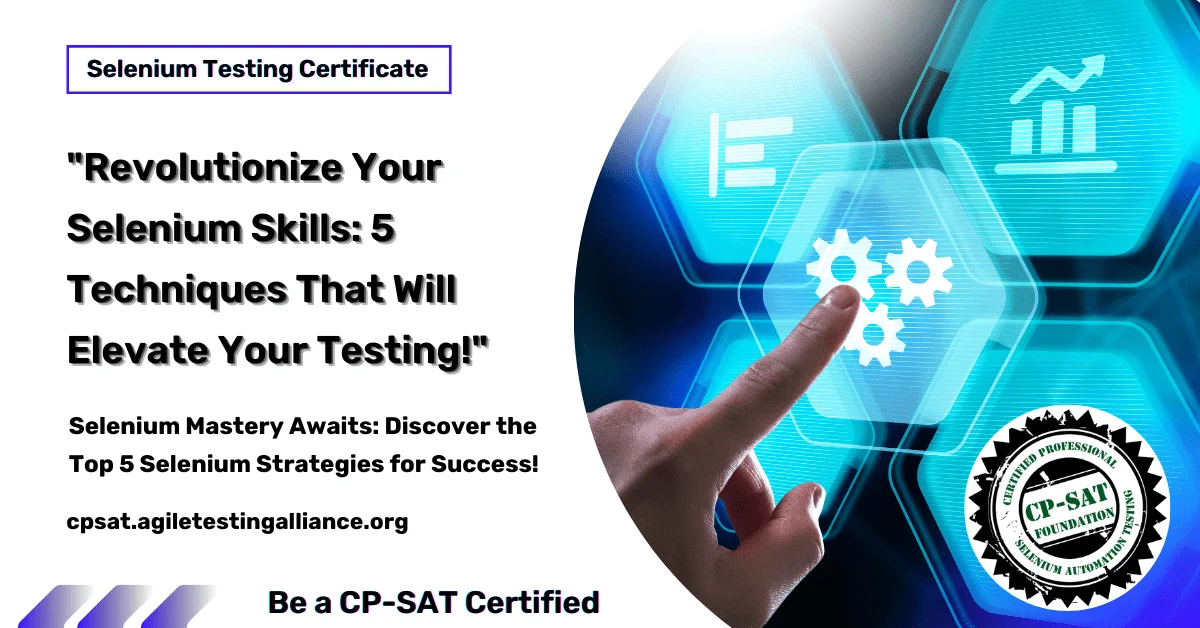
Cloud Testing: The Future You Can't Afford to Ignore

Table of Contents
Hello and welcome to a pivotal conversation that’s about to change your outlook on software testing. If you’re a fresher or a newcomer to this ever-evolving field, you’re likely captivated by the sheer variety of testing methods and tools available today. But here’s something you must zero in on: Cloud Testing. Trust me, it’s not just a buzzword; it’s an essential piece of the software testing puzzle that has global implications. So, why is it indispensable? Because we are stepping into a ‘Cloud-First’ future, and ignoring this shift could set you back, no matter where in the world you are based.
First, let’s discuss the elephant in the room. When we say “Cloud-First,” what we are pointing out is the accelerated adoption of cloud computing technologies across industries. Companies, both big and small, are embracing cloud solutions for their storage, operations, and yes, even testing needs. Consequently, this adoption has ushered in a new era of scalability, speed, and efficiency.
Now, you may wonder, “What exactly is cloud testing, and why should I care?” Great questions! Cloud testing leverages cloud computing resources to simulate real-world user traffic and various testing environments, eliminating the need for expensive in-house hardware. This makes it a perfect fit for freshers who are often faced with budget constraints and limited resources.
Moreover, if you’re aspiring to make a global impact, you should know that cloud testing transcends geographical limitations. With the cloud, you can simulate users from different regions without physically being there. It’s a win-win, irrespective of whether you’re a multinational conglomerate or a newbie looking to make your mark.
So, as we delve deeper into this critical topic, fasten your seatbelts for an enlightening journey. From the benefits of cloud testing to its seamless integration with Agile and DevOps methodologies, we have a lot to cover. And for those of you aiming for certification, pay close attention. The information contained here could be your golden ticket to acing CP-SAT or any other globally recognized testing certificate.
There you have it, a primer on why cloud testing is the future you can’t afford to ignore. It’s not just the next big thing; it’s the big thing right now. Ready to get started? Let’s dive in.
Part 1: The State of Software Testing in a Cloud-First World
Ah, the Cloud! It’s the word on everyone’s lips, and for a good reason. If you’re a newcomer to the testing landscape or a fresher eager to make your mark, understanding the Cloud’s influence on software testing is not optional; it’s essential. You see, we’ve transitioned into a Cloud-First world, and this shift is redefining how we approach software development and, by extension, software testing.
Why Cloud-First?
Firstly, let’s untangle what “Cloud-First” actually means. In layman’s terms, it’s a strategic choice by organizations to prioritize cloud computing solutions over traditional methods. This isn’t just a trend among Fortune 500 companies; even start-ups and SMEs are jumping on the bandwagon. With cost-efficient scalability, speedy deployments, and robust security measures, the cloud is altering the fundamentals of how businesses operate.
Software Testing: Then vs. Now
So, how does this Cloud-First paradigm shift affect software testing, especially for those of you who are freshers or newcomers? Well, let’s rewind a bit. Traditional testing methods relied heavily on physical infrastructure and in-house resources. The hardware was expensive, the setups time-consuming, and don’t even get me started on the limitations it imposed on scalability and global testing.
Fast forward to today, and you’ll see a stark contrast. Cloud testing enables you to bypass all these hurdles with ease. You can now perform load testing, stress testing, and even simulate real-world scenarios without purchasing any hardware. Just a few clicks, and voila, your cloud-based environment is set up.
Breaking Down Barriers
Perhaps the most significant advantage is the breaking down of geographical barriers. With cloud testing, you can effortlessly test how an application performs for users in different parts of the world. This is invaluable for anyone with a global perspective, laying the foundation for genuinely international products.
Setting Standards with CP-SAT
If you’re aiming for certifications like CP-SAT, the Certified Professional – Selenium Automation Testing, having a thorough understanding of cloud testing can give you a leg up. Why? Because CP-SAT and similar certifications are evolving to include questions on cloud computing and its applications in automation testing. So, gear up, the more you know, the better your chances of standing out in a crowded field.
Key Takeaways for Freshers and Newcomers
If you’re a fresher or a newcomer in this domain, the cloud is your playground. The possibilities it opens up are boundless. Embrace the cloud, get the necessary training, and you’ll have an edge that can catapult your career into realms you’ve never even imagined.
So there it is, folks. We’re living in a Cloud-First world, and it has far-reaching implications for software testing. The cloud is not just an added feature; it’s the new normal. As we journey through this blog series, we’ll delve into even more aspects of cloud testing that you’ll find valuable. So, stay tuned and get ready to unlock the next level of software testing!
Part 2: What is Cloud Testing?
So, we’ve established that the Cloud is the cornerstone of modern software practices, but what exactly does cloud testing entail? If you’re a fresher or a newcomer in the tech world, this is where you’ll want to pay close attention. Cloud testing is not just another buzzword; it’s a game-changer, and understanding it can turbocharge your journey in the world of software testing.
The Basics
Let’s begin with the basics. In simple terms, cloud testing is the practice of running software tests in a cloud environment. Unlike traditional testing, where you would need a dedicated server or hardware, here, you can leverage cloud resources. Think of it as testing “on-demand.” You spin up the resources when you need them and wind them down when you’re done, providing unprecedented flexibility.
Types of Cloud Testing
There are various forms of cloud testing, and being proficient in them can set you apart in this competitive field. Some commonly used approaches include:
Load Testing: To determine how your application behaves under peak conditions.
Performance Testing: For gauging how optimized your application is in terms of responsiveness and stability.
Security Testing: To ensure your app is bulletproof against threats.
Geographical Testing: To analyze how your application performs in different regions, particularly useful for global operations.
Why Cloud Testing is the Future
Here’s the million-dollar question: Why is cloud testing such a big deal, particularly for newcomers and freshers? Well, in today’s globally connected world, where remote work is not just an option but often a necessity, cloud testing allows seamless collaboration. No longer are you constrained by physical locations or time zones. Your team can access, modify, and execute tests from anywhere in the world.
CP-SAT and Cloud Testing
If you’re keen on becoming CP-SAT certified, or any other leading software testing certification for that matter, you’ll find an increasing emphasis on cloud testing in the syllabus. It’s vital to have hands-on experience and a deep understanding of how cloud-based environments work, as it’s becoming a significant part of the evaluation criteria.
Cost-Effectiveness
Another key advantage for freshers and newcomers is cost-effectiveness. Forget the days of investing in expensive hardware and time-consuming setups. The cloud provides an economical entry point into the realm of software testing.
In a Nutshell
So, what’s the takeaway here for those entering the world of software testing? Cloud testing is not just an exciting field; it’s rapidly becoming the standard. If you’re looking to make a career in this industry, understanding cloud testing is non-negotiable.
An Example to Bring It Home: Testing an E-commerce Platform
Imagine you’re a fresher who has recently landed a job as a Junior QA Tester at a startup that has an e-commerce platform. The holiday season is approaching, and the team wants to ensure that the website can handle increased traffic, offer seamless user experience globally, and ensure top-notch security. Sounds like a tall order, right? Let’s break it down through the lens of cloud testing.
Scenario 1: Load Testing
Traditionally, you’d have to set up multiple servers to simulate different traffic conditions and observe how your platform reacts. But with cloud testing, all you need to do is provision virtual servers on the cloud, perhaps using a service like AWS or Azure. With a few clicks, you can simulate thousands of users from different parts of the world visiting your website, buying items, and checking out—without ever having to physically set up multiple servers.
Scenario 2: Geographical Testing
Your startup has customers from Asia, Europe, and North America. With traditional setups, testing latency and user experience from these different locations could be cumbersome. With cloud testing, you can easily simulate these conditions by selecting data centers located in these regions for your tests.
Scenario 3: Security Testing
The cloud environment often comes with built-in security protocols, and you can run a suite of security tests without worrying about compromising your local network. Also, vendors frequently update their security measures, which means you’re always testing against the latest security benchmarks.
How Does This Help Freshers?
As a fresher, you don’t have to spend hours or even days setting up hardware or worrying about infrastructure costs. Cloud testing offers a plug-and-play solution. You learn faster, you’re more agile, and you’re gaining real-world, applicable skills that make you marketable in today’s global workforce. Also, this hands-on experience with cloud testing will be a feather in your cap when you decide to go for certifications like CP-SAT.
Part 3: Advantages of Cloud Testing
1. Cost-Effective
First and foremost, cloud testing is incredibly cost-effective. No need to buy or maintain in-house hardware for your testing needs. For those just stepping into the world of software testing, this significantly lowers the barriers to entry. It means you don’t have to break the bank to set up a robust testing environment.
2. Speed and Agility
Time is of the essence in today’s fast-paced tech environment. Cloud testing enables quick setup and teardown of test environments. This agility is invaluable for beginners, as you can quickly move from one project to the next, gaining diverse experience without getting bogged down by setup times.
3. Real-World Scenarios
Cloud testing allows you to test your application under real-world conditions. You can simulate different geographies, browser types, and even network conditions. This is a golden opportunity for freshers to understand how the applications they test will perform globally—a crucial skill in today’s interconnected world.
4. Scalability
Remember our e-commerce platform example? Well, the beauty of the cloud is that it’s effortlessly scalable. As your skills grow and you take on more complex projects, you can easily scale your cloud resources up or down depending on the test requirements. This flexibility can be a huge advantage for anyone at the beginning of their software testing career.
5. Continuous Integration and Continuous Testing
One of the buzzwords you’ll encounter a lot as a fresher is CI/CD or Continuous Integration and Continuous Deployment. Cloud testing fits seamlessly into these modern software development practices. Learning how to integrate cloud-based testing into CI/CD pipelines can make you a more versatile tester, opening up numerous job opportunities.
6. Built-in Tools and Frameworks
Last but not least, cloud platforms often come with a plethora of built-in tools and frameworks that can simplify the testing process. For a newcomer, this is like having a treasure trove of resources at your fingertips. You can quickly become familiar with popular tools in the industry, making you more marketable as a tester.
Part 4: Agile and Cloud Testing – A Symbiotic Relationship
The Essence of Agile
Let’s begin by briefly revisiting what Agile is. Agile is a software development methodology that emphasizes flexibility, collaboration, and customer-centricity. The focus is on iterative progress, adaptability, and delivering a functional product in a short time frame.
1. Flexibility and Adaptability
In an Agile environment, the requirements can change even late in the development cycle. This constant flux may sound like a challenge but it’s actually an advantage when coupled with cloud testing. With the cloud, you can easily set up, modify, or tear down test environments within minutes. For freshers, this means you’ll get hands-on experience in accommodating late-stage changes efficiently—a vital skill in today’s dynamic tech landscape.
2. Collaboration and Communication
Agile relies heavily on team collaboration, and cloud testing fits right into this framework. With cloud testing, multiple team members can access the same testing environment from anywhere in the world. Imagine the convenience and the real-world, global teamwork experience you’ll gain as a fresher!
3. Real-time Feedback Loop
The Agile approach demands constant feedback to iterate and improve the product. Cloud testing allows you to provide real-time results, making it easier to adapt to customer needs swiftly. As a newcomer, you’ll find this invaluable in understanding customer-centric development and testing.
4. Quick Turnaround Times
Agile sprints are typically short, ranging from a week to a month. The rapid provisioning and de-provisioning of resources in cloud testing align perfectly with these short cycles. The quicker you complete your testing cycles, the more projects you can tackle. It’s an excellent way for freshers to accumulate diverse experience quickly.
5. Cost Management
As we’ve discussed, cloud testing is incredibly cost-effective. In an Agile environment, this cost efficiency allows organizations to allocate resources more flexibly, providing more room for innovation and exploration—a golden ticket for those new to the field eager to explore various aspects of software testing.
Example: The Online Retail Platform
Imagine you’re a fresher working in a global team that’s developing an online retail platform. The team uses Agile methodology and is based in different parts of the world.
Scenario 1: Last-Minute Changes
Let’s say you’re in Sprint 4, and the client wants to introduce a new feature—real-time inventory tracking. In a traditional setting, adding this feature would require significant changes in the test environment, which would be both time-consuming and costly. However, with cloud testing, you can quickly configure a new test environment to incorporate these changes. As a newcomer, you will learn to handle real-time, client-driven changes—a valuable skill set in today’s fast-paced world.
Scenario 2: Collaboration Across Time Zones
You’re collaborating with developers and testers across the globe. Traditionally, you would need to wait for the office hours that overlap. With cloud testing, any team member can access the testing environment at any time. This 24/7 availability allows for true global collaboration, teaching you practical skills about how teams operate worldwide.
Scenario 3: Real-time Feedback and Adaptation
Your client wants to see a prototype as soon as possible. Agile is all about immediate feedback and quick iterations. By using cloud-based testing environments, you can share test results in real-time with the client. As a fresher, this exposure to client interactions and quick feedback loops will be invaluable as you grow in your career.
Scenario 4: Budget Constraints
As a startup, your team has limited resources. Cloud testing allows you to only pay for the resources you use. Because of this cost-effectiveness, your company can allocate more funds toward innovative projects. As someone new to the field, you get the opportunity to work on these innovative projects early in your career.
Part 5: The Technology Stack – Languages and Tools for Cloud Testing
The Foundation: Programming Languages
Firstly, let’s consider programming languages like the foundation of your construction project. Whether you’re a newcomer or someone transitioning from a different career, you may find the options like Java, Python, and C# overwhelming. Each language is like a different type of foundational material: some are easier to work with, like Python, which is highly praised for its ease of use and quick learning curve. Java offers a sturdy foundation with extensive libraries and community support. Choose your foundational material carefully, based on the requirements of your project.
The Scaffolding: Frameworks
Frameworks like JUnit, TestNG, NUnit, and Pytest act as the scaffolding that enables you to reach and validate different parts of your construction safely and efficiently. Knowing these frameworks gives you the ability to carry out precise work, no matter how high you need to reach. For those who are new, becoming proficient in at least one framework for each language you know is highly beneficial.
The Project Plan: CI/CD Tools
Think of Continuous Integration and Continuous Deployment (CI/CD) tools like Jenkins and Maven as your detailed project plan. They coordinate all the changes and updates, making sure everything is integrated smoothly from your local development environment to the actual construction site (production environment). Becoming familiar with CI/CD tools early on will serve you well in your career.
The Heavy Machinery: Selenium Grid and Docker
Selenium Grid and Docker containers are the heavy machinery in your toolkit, allowing you to accomplish large tasks more efficiently. Selenium Grid lets you run multiple tests in parallel, across different environments, ensuring you meet project deadlines. Docker, on the other hand, ensures that you can transport all your tools and materials (code and dependencies) in a standardized container, guaranteeing they’ll function the same way no matter where they’re used.
The Logistics: Cloud Providers
Lastly, Cloud providers like AWS, Azure, and Google Cloud are your logistics providers, offering you the spaces where all these operations are executed. With the advent of cloud testing, knowing how to navigate these platforms becomes a unique skill set, making you stand out globally.
So, you might be wondering if you need to be a master of all these tools. The straightforward answer is no, but a fundamental understanding of each component in this toolkit will definitely make you a versatile tester. This adaptability is invaluable in a rapidly evolving field like ours, regardless of where you are in the world.
There you go—a well-rounded view of the technology stack crucial for cloud testing. These tools are universally useful, so don’t underestimate their significance. Happy building!
Part 6: Case Studies – Global Successes
Ah, the proof is in the pudding, as they say! So far, we’ve discussed the nitty-gritty of cloud testing, its symbiotic relationship with Agile, and the technology stack you’ll need. Now, let’s delve into some real-world examples that bring all these elements together. Whether you’re a fresher or a newcomer, seeing how others have navigated this territory can be invaluable for your journey.
Success Story 1: Cutting Costs with Cloud Testing
First off, let’s talk about a global e-commerce giant that needed to revamp its testing procedures. With thousands of product pages that required frequent updates and a myriad of customer experiences to validate, the cost of maintaining a local testing environment was skyrocketing. Transitioning to cloud testing not only brought down the costs but also streamlined their testing pipeline, improving time-to-market. For new testers, this case study underscores the cost-effectiveness of cloud testing, an element that’s just as important as efficiency or scalability.
Success Story 2: Scalability for a Social Media Platform
Next up is the tale of a rapidly growing social media platform that went from a few thousand to millions of users in a short span. The uniqueness here lies in how they integrated Agile methodologies with cloud testing. They used Agile’s sprint-focused approach to break down testing tasks, and then executed these tasks using Selenium Grid on AWS. This allowed for extensive parallel testing, resulting in quicker test cycles and happier users. So, if you’re looking to break into software testing, understanding how Agile and cloud can work together could be your ticket to contributing significantly to a high-impact project.
Success Story 3: Localizing Global Products
Here’s a story for those interested in localization testing. A global finance app wanted to expand its services to multiple countries. Utilizing cloud testing, they were able to simulate local network environments and validate the user experience in each country. This was done seamlessly without having to set up local testing rigs in each location. For freshers, this serves as a great example of how versatile cloud testing is. You’re not just testing; you’re globally ensuring the quality of a product.
Success Story 4: Quick Fixes with CI/CD
Last but not least, let’s focus on a global healthcare platform that integrated Jenkins and Maven for CI/CD into their cloud testing procedures. This allowed them to automate the entire testing lifecycle, from code commits to production deployment. For newcomers, this demonstrates how mastering the technology stack is not just about testing but extends to ensuring quicker fixes and, ultimately, a more robust end product.
Take inspiration, but also take action. Equip yourself with the right skills, and who knows, maybe your success story could be the next one I discuss. Happy testing!
Part 7: The Road Ahead – Future Trends
Ah, the future—always so full of promise yet shrouded in mystery. But if you ask me, in the world of technology, especially cloud testing, you can actually see some of the future coming, and it’s exhilarating! In this final segment, we’ll don our visionary caps and look at emerging trends that are set to redefine the contours of cloud testing. I assure you, for newcomers and freshers, this is where the rubber meets the road. The future isn’t a vague concept; it’s unfolding as we speak, and you’ll want to be ready for it.
The Advent of AI and ML in Cloud Testing
Artificial Intelligence and Machine Learning are not just buzzwords anymore; they are transforming the testing landscape. Imagine automated testing that evolves by itself, learning from each iteration. As a newbie, you have the golden opportunity to ride this wave from the get-go. Picture yourself pioneering AI-driven testing strategies—exciting, isn’t it?
IoT Testing Goes Cloud
Internet of Things (IoT) devices are sprouting everywhere, from smart homes to industrial setups. And yes, they need to be tested too. As these devices proliferate, the logical next step is cloud-based IoT testing. For beginners in the field, grasping the nuances of IoT and cloud-based testing can place you in a highly specialized niche.
The Intersection of DevOps and Cloud Testing
DevOps culture is becoming more and more prevalent, emphasizing rapid development cycles and continuous delivery. Here’s the kicker: DevOps and cloud testing are converging. The cloud offers a perfect environment for DevOps practices like Continuous Integration and Continuous Deployment (CI/CD). If you’re just starting out, understanding this synergy can make you highly marketable.
Rise of Security Testing in the Cloud
Security isn’t an afterthought; it’s a necessity. As more services move to the cloud, security testing in the cloud is gaining unprecedented attention. The scope is enormous here. Newcomers, take note—being savvy in cloud security protocols could set you apart from the crowd.
Shift from Performance to Resilience Testing
We’re moving beyond asking if the system is fast enough to asking if it’s resilient enough. In the face of outages, cyber-attacks, and peak loads, how does your system hold up? This is where resilience testing comes in. For freshers, it’s crucial to learn not just how to test for performance but how to ensure resilience in the cloud environment.
Sustainability in Testing
Last but not least, sustainability is making its way into the conversation. As the globe becomes more environmentally conscious, even the world of cloud testing will likely pivot toward more sustainable practices. It’s an exciting avenue that might open up new job roles and responsibilities.
To sum up, cloud testing is an ever-evolving field that’s both dynamic and challenging. For newcomers, it’s an opportune time to enter this sphere, especially with the future promising a blend of technology, strategy, and sustainability. So, strap in and get ready for a fascinating journey into the future of cloud testing. It’s a future you can’t afford to ignore, and it starts now. Happy future-proofing!
Conclusion
Well, we’ve covered quite a bit of ground, haven’t we? From understanding the nuts and bolts of cloud testing to diving into its symbiotic relationship with Agile, and finally peeking into the not-so-distant future—this has been a comprehensive exploration. If you’re a newcomer or a fresher looking to break into the world of cloud testing, this is your moment. Truly, there has never been a more exciting time to be part of this technological revolution that’s sweeping across industries and countries.
So, what are your key takeaways? I hope you now see the immense value that cloud testing brings, not just as a technological advancement but as a career catalyst. It’s an area bursting with innovation and brimming with opportunities. Consider how AI and ML are becoming integrated into cloud testing, how DevOps is enhancing the cloud experience, and how the role of security is ever-so-important in this interconnected, global ecosystem. These aren’t just trends; they are career pathways waiting for you to embark on them.
It’s worth emphasizing that you don’t have to be a seasoned professional to make a meaningful impact. Freshers have the benefit of starting with a clean slate, unburdened by legacy technologies or outdated practices. You have the opportunity to learn the latest tools and techniques, such as Selenium 4.x, Docker containers, and GIT integration. These are not just bullet points on a resume; they are skill sets that can set you apart in the global job market.
Finally, let’s talk about continual learning. As you can see, cloud testing is not a static field; it’s ever-changing and ever-growing. Hence, staying updated is not just an advantage—it’s a necessity. Whether you choose to pursue certifications like CP-SAT or opt for practical, hands-on experience, never stop learning. It’s the surest way to not only stay relevant but to excel and lead in your career.
Thank you for taking this enlightening journey with me. I look forward to hearing about your adventures and triumphs in cloud testing. The road ahead is thrilling, and it’s paved with endless possibilities. So why wait? Take that first step into your future, because, trust me, this is one area you can’t afford to ignore.
Until next time, happy testing!











